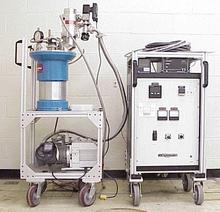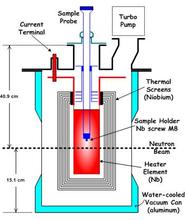This is the general use furnace that is available for use on all instruments except HFBS and BT4. It is made up of a water cooled aluminum outer vacuum can containing a niobium resistive heating element surrounded by niobium heat shields. The sample is top loaded on a stick, but the furnace must be brought to room temperature for sample changing. The sample stick has a threaded stud for sample can mounting. Use of this system requires the assistance of a sample environment team member.
| Sample Geometry |
|---|
| Sample Holder |
Top Loading Stick with Male M8 Thread |
| Sample Access In Plane |
350o |
| Sample Access Out of Plane |
+20o |
| Maximum Sample Diameter |
4.2cm (1.65 in) |
| Maximum Sample Height |
12cm (4.72 in) |
|
|
Sample Preparation
Safety Issues
Experiment Planning
More Information:
-
- Sample Holders: The sample probe terminates in a threaded M8-1.25 stud. A user designed (NIST assistance is available) holder compatible with our probe is required. Ventilated (i.e. non-pressure building) crucible-type holders made of niobium or platinum are recommended. Any sealed sample holder must be tested off-line at the maximum desired temperature before loading into the furnace to ensure that an over-pressure burst will not occur on the beam line.
- Sample Geometry:
- Note that the beam center is 40.9cm below the top of the sample well, and the probe height is adjustable to accommodate a wide range of sample sizes.
- Your probe/sample length must be adjusted so that it DOES NOT TOUCH THE HEATING ELEMENT OR THE BOTTOM OF THE SAMPLE WELL
- The furnace must be operated under high vacuum (less than 10-4 Torr).
- KNOW YOUR SAMPLE!! Users must verify that their sample will maintain low vapor pressure (< 10-5 Torr) and not react with its surroundings at high temperature; since the heating element along with all of the heat shields in the furnace are made of niobium (refractory material that readily oxidizes at temperatures above 150 degrees Celsius).
- The furnace requires high vacuum and proper water flow for safe operation. There are two safety interlock systems: One is for over-temperature and is controlled by the small temperature reader on the upper right of the control unit. The vacuum gauge and the water-flow switch share the other. The furnace will not operate if either of these interlocks is not functioning.
- Set appropriate current limits. If using the manual ramping, do not jolt the furnace with high current spikes. Slowly increment the output limit setting and/or ramp your setpoint for smooth operation.
- Note that this is a high temperature furnace that performs best at higher temperature.
- Plan ahead. At most it will take 2 hours for the sample to reach 1600oC.
- Leave time at the end of the experiment to allow the sample cell to cool in order to remove the sample stick.
- Design the experiment with proper sample mounting and ultimate sample temperature requirements in mind.



